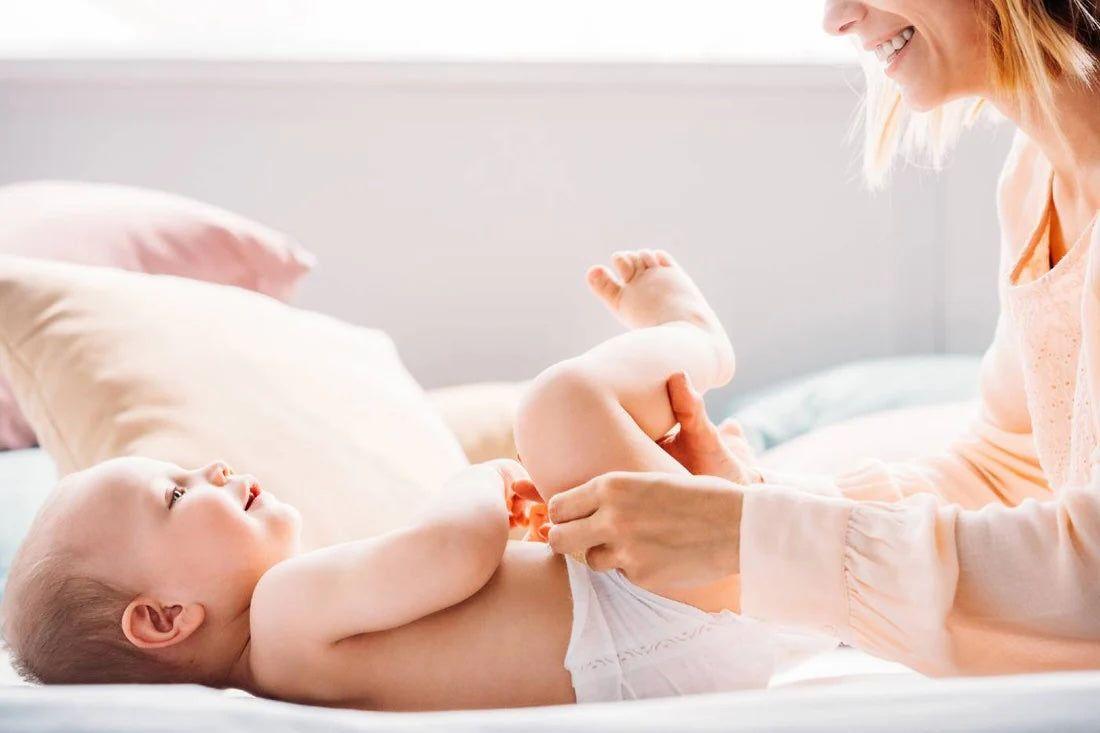BABY
How Many Nappies Does a Baby Use?
We make nappy math easy, breaking down how many you’ll need in Baby’s first year.

Written by
Happiest Baby Staff

SHARE THIS ARTICLE
PARENT PICKS
Bestsellers
BABY

Written by
Happiest Baby Staff

SHARE THIS ARTICLE
Bestsellers
It doesn’t matter if you’re debating whether or not to add nappies to your baby registry, staring down the expansive nappy aisle at your local big box store, or sending your panicked partner out for nappies the second you feel a contraction—making nappy decisions is not easy! There are so many baby nappy questions to answer, like How many nappies do I need? How do I know what size nappy to buy? Is there any difference between nappy brands? Gah! Before you buy too many nappies (or too little), let us help you zero in on the number of nappies you’ll truly need.
If you’re breastfeeding your newborn, there’s a good chance your little one will poop after every nursing session. (Since newborns have teeny bellies, they may breastfeed every one to three hours, or between eight to 12 times a day.) At the same time, some breastfed newborns will only poop three to four times a day. (By the time your baby reaches 1 to 2 months old, their poop will thicken and occur once a day or less.) And we haven’t even mentioned pee yet! Your little one may pee as often as every one to three hours—or as infrequently as four to six times a day. So…what does that nappy math shake out to? You should plan on up to 12 nappies a day during the first month, knowing that nappy math is not an exact science!
While every baby is different, research shows that the average baby goes through six to 10 nappies a day. The kicker? The five-nappy-a-day number is an average over three years of nappies—and the nappy habits of a 2-month-old is different from, say, a 12-month-old. When it comes to the real nappy number crunch, most parents will go through nearly 3,000 nappies during their baby’s first year! Here’s the general month-by-month breakdown of how many nappies your baby will need:
In general, babies go through 8 to 10 cloth nappies a day. It’s often recommended that you have between 20 and 24 cloth nappies in total—regardless of the style you choose. This allows you a little breathing room to wash your cloth nappies every other day. With cloth nappies, you’ll need to change poopy nappies as soon as possible and you’ll want to change wet nappies…
While it all depends on your baby’s poop situation, you’ll generally need three to four wipes per dirty nappy change. BUT wet nappies are a totally different story. You don’t need to use a baby wipe after every nappy change! (Mind-blowing, right?) The reason: Pee that hasn’t been sitting long is rarely irritating to Baby and today’s ultra-absorbent disposable nappies does a fantastic job of limiting the amount of urine your baby’s skin is ever exposed to. Their advice: Save wipes for cleaning up poopy nappies. Also, know that a moist tissue, a wet washcloth—or even a quick tub-rinse all do the same job as a baby wipe.
Need breakdown of baby nappy sizes by age and weight? Here’s a handy nappy size and weight chart:
If your baby’s weight straddles two nappy sizes, it’s often best to size up. (Too-tight nappies can cause chafing and nappy rash.)
Unsure if your little one’s nappy fits properly? Check their belly button. A properly fitting nappy should sit just under the navel. When Baby’s nappy is fastened, you should be able to slide two fingers around the nappy's waistband and your little one’s tummy. The nappy should look straight and proportioned on your baby. Finally, it's a good idea to check the nappy's leg elastic, making sure that there are no gaps. (Run your finger under the cuff to ensure its laying properly.)
Yes and no. Yes, it’s good to be prepared and have a stash of nappies on hand as soon as your baby makes their arrival. But you don’t want to over buy for a few reasons: You might wind up with 300 nappies that you—or your baby—don't love. (Leaks! Rash! Wrong size!) Or you could have a nappy stash in the wrong size. The best way to stock up:
Dr. Harvey Karp recommends that you change your baby’s nappy roughly every two to three hours—and whenever you notice your little one has pooped. This is important because pee and poo irritate Baby’s sensitive nappy areas and cause nappy rash. Baby poop is especially acidic—especially in the first weeks. And when urine sits too long in a baby’s nappy, it turns into ammonia, which is very irritating.
If your baby is sound asleep, there’s no real need to wake them to change their nappy—unless, of course, their nappy is leaking and making a big, ol mess. If you are offering Baby a dream feed, know that there’s no need to automatically change your baby’s nappy beforehand. But if your baby’s nappy is dirty, change it before feeding.
To help keep Baby dry and nappy rash-free overnight, follow these tips:
Disclaimer: The information on our site is NOT medical advice for any specific person or condition. It is only meant as general information. If you have any medical questions and concerns about your child or yourself, please contact your health provider. Breastmilk is the best source of nutrition for babies. It is important that, in preparation for and during breastfeeding, mothers eat a healthy, balanced diet. Combined breast- and bottle-feeding in the first weeks of life may reduce the supply of a mother's breastmilk and reversing the decision not to breastfeed is difficult. If you do decide to use infant formula, you should follow instructions carefully.